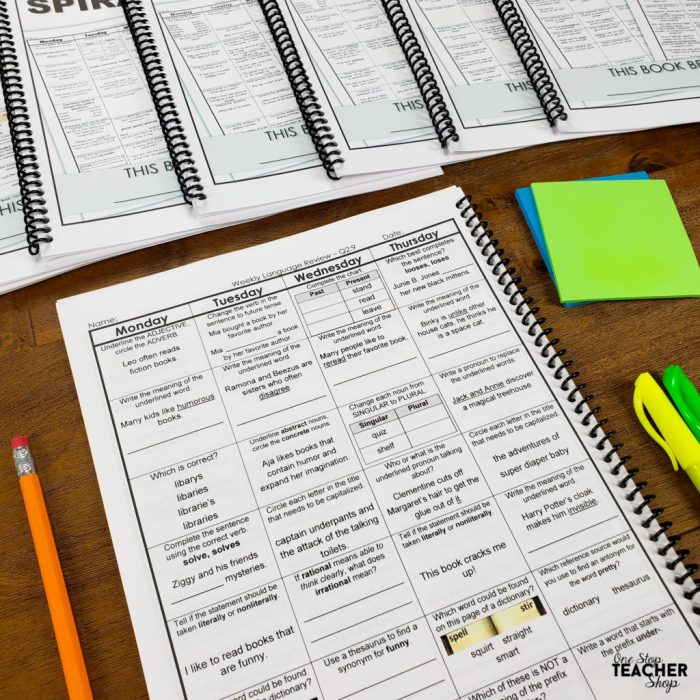Welcome to our comprehensive guide on Weekly Language Review Q1 4 Answers. This resource delves into the intricacies of language reviews, providing a structured framework for organizing, assessing, and enhancing language skills. Get ready to embark on a journey that will revolutionize your approach to language learning.
This guide covers the fundamental concepts, structure, content, assessment techniques, and implementation strategies for weekly language reviews. Whether you’re a teacher, student, or language enthusiast, this guide will empower you with the knowledge and tools to maximize your language learning outcomes.
Definition and Overview
A weekly language review is a systematic process of revisiting and reinforcing previously taught language material within a one-week time frame. It provides students with regular opportunities to consolidate their understanding, improve their proficiency, and identify areas that require further attention.
Common elements included in a weekly language review may encompass vocabulary exercises, grammar drills, reading comprehension tasks, listening comprehension activities, and speaking practice.
Structure and Organization
Suggested Table Format
| Language Skill | Activities | Assessment Methods | Feedback and Tracking |
|---|
Suggested Categories or Sections
- Vocabulary
- Grammar
- Reading Comprehension
- Listening Comprehension
- Speaking Practice
Language Review Content: Weekly Language Review Q1 4 Answers

Purpose of Specific Language Skills
- Vocabulary:To expand students’ lexical knowledge and improve their ability to communicate effectively.
- Grammar:To reinforce grammatical concepts and improve students’ accuracy in using the language.
- Reading Comprehension:To develop students’ reading skills, including comprehension, fluency, and critical thinking.
- Listening Comprehension:To enhance students’ listening skills, including comprehension, discrimination, and retention.
- Speaking Practice:To provide students with opportunities to practice speaking the language and improve their fluency and pronunciation.
Examples for Each Language Skill
- Vocabulary:Word lists, flashcards, matching exercises, fill-in-the-blanks.
- Grammar:Sentence construction exercises, error correction, gap-filling exercises.
- Reading Comprehension:Short stories, articles, comprehension questions, summaries.
- Listening Comprehension:Audio recordings, podcasts, dialogues, dictation.
- Speaking Practice:Role-plays, discussions, presentations, pair work.
Assessing Student Progress, Weekly language review q1 4 answers
- Vocabulary:Vocabulary tests, word games, oral recall.
- Grammar:Grammar quizzes, sentence analysis, error correction.
- Reading Comprehension:Comprehension questions, summaries, discussions.
- Listening Comprehension:Listening tests, dictation, comprehension questions.
- Speaking Practice:Oral presentations, role-plays, peer feedback.
Assessment and Feedback
Assessing Student Understanding
- Formal assessments (e.g., tests, quizzes)
- Informal assessments (e.g., observation, participation, homework)
- Self-assessment (e.g., student reflection, goal setting)
Providing Constructive Feedback
- Focus on specific areas for improvement.
- Provide clear and actionable suggestions.
- Encourage students to self-reflect and identify their own strengths and weaknesses.
Tracking Student Progress
- Use a variety of assessment methods to gather data.
- Track student progress over time to identify trends and areas for intervention.
- Use data to inform instructional decisions and adjust the review accordingly.
Implementation and Resources
Benefits of Implementing a Weekly Language Review
- Reinforces previously taught material.
- Improves student proficiency and confidence.
- Identifies areas for further instruction.
- Provides regular opportunities for practice and feedback.
Suggested Resources
- Textbooks and workbooks
- Online language learning platforms
- Authentic materials (e.g., newspapers, articles, videos)
- Language learning apps
Integrating the Review into Existing Lesson Plans
- Allocate a specific time slot for the review.
- Incorporate review activities into regular lessons.
- Use review material as a warm-up or closing activity.
Q&A
What is the purpose of a weekly language review?
Weekly language reviews provide a structured opportunity to revisit and reinforce previously learned material, assess student understanding, and identify areas for improvement.
How should I structure a weekly language review?
Organize the review into responsive columns, including categories such as vocabulary, grammar, reading, and writing. This structure facilitates efficient review and assessment.
What language skills should be included in a review?
Include skills such as vocabulary acquisition, grammar comprehension, reading fluency, writing accuracy, and pronunciation practice to ensure comprehensive language development.
How can I assess student progress in language skills?
Use a variety of assessment methods, such as quizzes, written exercises, oral presentations, and self-reflection, to evaluate student understanding and identify areas for improvement.
How do I integrate a weekly language review into my lesson plans?
Schedule the review at a consistent time each week and allocate sufficient time for students to complete the activities. Integrate the review into the broader curriculum by connecting it to current lesson topics and assignments.